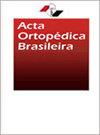髓内钉治疗胫骨干骨折的楔形碎片变异。
IF 0.5
4区 医学
Q4 ORTHOPEDICS
引用次数: 0
摘要
胫骨干骨折是最常见的长骨骨折,标准的治疗方法是髓内钉固定。无论这项技术的发展如何,假关节仍然普遍存在。目的:评估楔形碎片大小与移位、42B2型主要碎片移位和假关节发生率的相关性。方法:回顾性分析2015年1月至2019年12月所有采用内钉治疗的42B2型骨折患者。术前正位片(AP)和侧位片确定了6个影像学参数。术后3个月、6个月和12个月的x线片确定了另外6个参数。胫骨骨折放射联合评分用于评估骨愈合。结果:355例胫骨干骨折患者中,51例纳入研究。男性41例(82.0%),平均年龄36.7岁,开放性骨折37例(72.5%),合并损伤28例(54.9%)。经统计分析,与骨不愈合有显著相关的因素是楔形高度> 18 mm,术前AP位骨折平移位移> 18 mm, IM钉入后楔形相对于其原始解剖位置的最终距离> 5 mm。楔形骨折和42b2骨折不愈合的危险因素是楔形高度> 18mm,骨折AP视图初始位移> 18mm, IM钉入后楔形与解剖位置的距离> 5mm。证据等级III;回顾性比较研究。本文章由计算机程序翻译,如有差异,请以英文原文为准。
WEDGE FRAGMENT VARIATIONS OF TIBIAL SHAFT FRACTURES WITH INTRAMEDULLARY NAILING.
ABSTRACT Introduction: Tibial shaft fracture is the most common long-bone fracture, and the standard treatment is intramedullary (IM) nail fixation. Regardless of the development of this technique pseudoarthrosis remains prevalent. Objectives: Evaluate the correlation between wedge fragment size and displacement, displacement of the main fragments of the 42B2 type, and pseudoarthrosis incidence. Methods: We retrospectively assessed all patients with 42B2 type fracture treated with IM nailing between January, 2015 and December, 2019. Six radiographic parameters were defined for preoperative radiographs in the anteroposterior (AP) and lateral views. Another six parameters were defined for postoperative radiographs at three, six, and 12 months. The Radiographic Union Score for Tibial Fractures score was used to assess bone healing. Results: Of 355 patients with tibial shaft fractures, 51 were included in the study. There were 41 (82.0%) male patients, with a mean age of 36.7 years, 37 (72.5%) had open fractures, and 28 (54.9%) had associated injuries. After statistical analysis, the factors that correlated significantly with nonunion were wedge height > 18 mm, preoperative translational displacement of the fracture in the AP view > 18 mm, and final distance of the wedge in relation to its original anatomical position after IM nailing > 5 mm. Conclusion: Risk factors for nonunion related to the wedge and42B2 fracture are wedge height > 18 mm, initial translation in the AP view of the fracture > 18 mm, and distance > 5 mm of the wedge from its anatomical position after IM nailing. Evidence level III; Retrospective comparative study .
求助全文
通过发布文献求助,成功后即可免费获取论文全文。
去求助
来源期刊

Acta Ortopedica Brasileira
Orthopedics-
CiteScore
0.90
自引率
14.30%
发文量
67
审稿时长
25 weeks
期刊介绍:
A Revista Acta Ortopédica Brasileira, órgão oficial do Departamento de Ortopedia e Traumatologia da Faculdade de Medicina da Universidade de São Paulo (DOT/FMUSP), é publicada bimestralmente em seis edições ao ano (jan/fev, mar/abr, maio/jun, jul/ago, set/out e nov/dez) com versão em inglês disponível nos principais indexadores nacionais e internacionais e instituições de ensino do Brasil. Sendo hoje reconhecidamente uma importante contribuição para os especialistas da área com sua seriedade e árduo trabalho para as indexações já conquistadas.
 求助内容:
求助内容: 应助结果提醒方式:
应助结果提醒方式:


